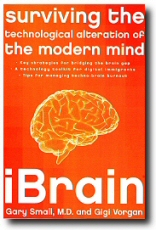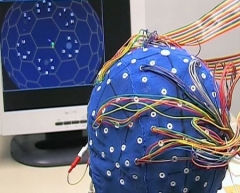The Brain Technology Built: An Interview with Dr. Gary Small
 “If you think our incessant use of the Internet, Blackberrys, iPods, text-messaging and video games has changed our lives and our children’s lives, here’s some breaking news: Technology has not only altered our lives, it’s altered our brains.” That’s the contention of Gary Small, M.D., Director of the UCLA Memory & Aging Research Center at the Semel Institute for Neuroscience & Human Behavior. In his latest book, iBrain: Surviving the Technological Alteration of the Modern Mind, he and co-author Gigi Vorgan discuss the brain that technology built – the evolutionary way.
“If you think our incessant use of the Internet, Blackberrys, iPods, text-messaging and video games has changed our lives and our children’s lives, here’s some breaking news: Technology has not only altered our lives, it’s altered our brains.” That’s the contention of Gary Small, M.D., Director of the UCLA Memory & Aging Research Center at the Semel Institute for Neuroscience & Human Behavior. In his latest book, iBrain: Surviving the Technological Alteration of the Modern Mind, he and co-author Gigi Vorgan discuss the brain that technology built – the evolutionary way.For those not familiar with your work, please describe your latest project.
We know that technology is changing our lives, but it is also changing our brains. Young people spend more and
 more time today using technology (computers, PDAs, TV, videos) and much less time engaged in direct social contact. Our UCLA brain scanning studies are showing that such repeated technology exposure alters brain circuitry, and young developing brains, which usually have the greatest exposure, are the most vulnerable.
more time today using technology (computers, PDAs, TV, videos) and much less time engaged in direct social contact. Our UCLA brain scanning studies are showing that such repeated technology exposure alters brain circuitry, and young developing brains, which usually have the greatest exposure, are the most vulnerable.I believe that this perpetual technology exposure is leading to the next major milestone in brain evolution. Over 300,000 years ago, Neanderthals discovered hand-held tools, which led to the co-evolution of language, goal-directed behavior, social networking, and accelerated development of the frontal lobe, which controls these functions. Today, video-game-brain, Internet addiction, and other technology side effects appear to be suppressing frontal lobe executive skills and our ability to communicate face-to-face. Instead, our brains are developing circuitry for on-line social networking and adapting to a new multitasking technology culture.
You make a distinction between two groups: digital natives and digital immigrants. What defines these groups and why is this distinction important?
Instead of the traditional generation gap, we are witnessing the beginning of a brain gap separating digital natives, born into 24/7 technology, and digital immigrants, who came to computers and other digital technology as adults. We know that older people are less likely to use technology compared with younger people.
For example, The Pew Internet & American Life Project reported 72 percent of people ages 51 to 59 years and 54 percent of those between ages 60 and 69 years went online, and more than 90 percent of teens use the Internet. A younger brain is more sensitive to the technology exposure. Young people might do better if they balance their tech time with off-line activities to help their brains develop complex reasoning abilities in the frontal lobe, as well as empathy skills in the temporal lobe.
In the last twenty years or so, we’ve heard about the growing technological corollary to the “haves / have nots” gap. But it seems like the new technologies are becoming more and more ubiquitous and accessible, not less. In your view, should this gap still be a concern?
What’s different about the new technology is its pace of innovation. Moreover, it exaggerates and accelerates many aspects of behavior and culture. The “have/have not” dichotomy will always be. In some ways the digital age will widening that gap; in other ways it will narrow it since as we perfect the technology it becomes less expensive and more available. For example, a surprisingly high number of people have access to cell phones and computers in even poverty-stricken, developing nations.
In graduate school I remember reading Neil Postman’s book, Amusing Ourselves to Death, a manifesto on how overexposure to media technology (especially TV) is destroying our capacity for critical thought – and this is a common theme in technology evaluations (it was recently reawakened in Gary Bauerline’s book, The Dumbest Generation: How the Digital Age Stupefies Young Americans and Jeopardizes Our Future). What’s your response to this position? Is the negativity and apprehension justified?
Our new technologies, like our brains, are complex. Exposing the brain to some forms of technology at certain points in development can impair function, while other forms of technology at other time points can enhance brain capacity. New technologies have been found to improve memory, reaction time, and peripheral vision. They can also facilitate communication and learning, and enhance our work and play.
Potential negative effects include increased frequency of errors from multi-tasking, worsening of attention, the risk of technology addiction, and a decline in face-to-face human contact abilities. It’s important for us to recognize the impact of technology on our brains and make choices that enhance our lives.
What for you is the most exciting scientific and/or technological advancement on the horizon?
 New research on brain-computer interface technologies are exciting. These technologies detect and translate the brain’s physiological electrical signals in order to control an output device, such as a keyboard, computer cursor, or even a prosthetic limb. Initially developed to assist people with severe motor disabilities, these methods could lead to the next evolutionary leap in human brain development.
New research on brain-computer interface technologies are exciting. These technologies detect and translate the brain’s physiological electrical signals in order to control an output device, such as a keyboard, computer cursor, or even a prosthetic limb. Initially developed to assist people with severe motor disabilities, these methods could lead to the next evolutionary leap in human brain development.Brain-reading technology using pulsed ultrasonic signals to transmit information directly into the mind is in development, and Pentagon scientist Stu Wolf believes that within the next few decades, we’ll be wearing computer headbands for “network-enabled telepathy” that will allow us to transmit our thoughts directly from our minds, through the Internet, into the mind of someone else, also wearing a headband.
Fifty years from now, what how far will we be along the path of understanding how our minds really work?
Not far into the future, we will have the capacity to monitor and stimulate brain activity of individual cells or neurons. Scientists already have a new apparatus that uses a photosensitive protein controlled by a laser down to the millisecond, the time dimension of a brain cell’s natural communication speed. This technology will permit the manipulation of individual neurons through the laser’s stimulation. The cure for the senior moment of the future brain may be as simple as turning on a laser light-switch. And of course, we’ll soon be checking and correcting our neural circuitry through a remote control, perhaps the same device we use to keep track of our TiVo Playlist.
Below is a brief interview Dr. Small gave to CBS on the topic of the changing brain.
Link to Dr. Small’s website
No comments:
Post a Comment